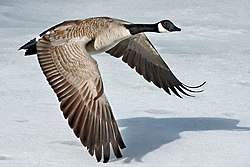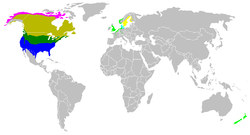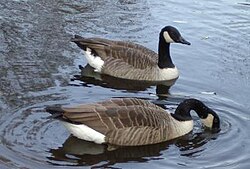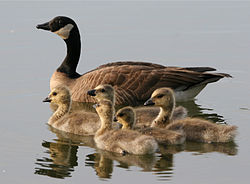Difference between revisions of "Field Guide/Birds/Branta canadensis"
m (474 revisions: re-import from WB, including edit history) |
|||
| (334 intermediate revisions by 60 users not shown) | |||
| Line 1: | Line 1: | ||
| − | {{ | + | {{Bird id |
| − | |||
| name = Canada Goose | | name = Canada Goose | ||
| − | | | + | | latin_name = Branta canadensis |
| − | | | + | | level = 4 |
| − | | image_width = 240px | + | | image_1 = Canada-Goose-Szmurlo.jpg| image_width = 240px |
| − | | | + | | caption_1 = Canada Goose in flight |
| − | | | + | | image_2 = Wildgans-schwarzer-kopf-fuerth.jpg |
| − | | | + | | caption_2 = Breeding pair |
| − | | | + | | image_3 = Branta canadensis1.jpg |
| − | | | + | | caption_3 = Female with goslings |
| − | | | + | | range_map = Branta canadensis map.png |
| − | + | | call = Branta canadensis.ogg | |
| − | | | + | | description = The '''Canada Goose''' (''Branta canadensis'') belongs to the ''Branta'' genus of geese, which contains species with largely black plumage, distinguishing them from the grey species of the ''Anser'' genus. |
| − | |||
| − | |||
| − | | | ||
| − | |||
| − | |||
| − | |||
| − | |||
| − | |||
| − | |||
| − | |||
| − | |||
| − | The | + | The black head and neck with white "chinstrap" distinguish this goose from all except the Barnacle Goose, but the latter has a black breast, and grey, rather than brownish, body plumage. There are seven subspecies of this bird, of varying sizes and plumage details, but all are recognizable as Canada Geese. Some are hard to distinguish from the Cackling Goose (''Branta hutchinsii''), with which the Canada Goose was long assumed to form one species; the name Lesser Canada Goose is, confusingly, often applied to ''B. hutchinsii''. |
| − | + | This species is 90-100 cm long with a 160-175 cm wing span. Males weigh {{units|3.5–6.5 kg|8–14 pounds}}, and can be very aggressive in defending territory. The female looks virtually identical but is slightly lighter at {{units|3–5.5 kg|7–12 pounds}}, and has a different honk. Exceptionally, weights of {{units|11.3 kg|25 pounds}} and a wingspan of {{units|224 cm|88 inches}} have been recorded in the largest race. | |
| − | + | These birds feed mainly on plant material. When feeding in water, they submerge their heads and necks to reach aquatic plants, sometimes tipping forward like a dabbling duck. Flocks of these birds often feed on leftover cultivated grains in fields, especially during migration or in winter. | |
| − | + | During the second year of their lives, Canada Geese find themselves a mate. Most couples stay together all of their lives. If one is killed, the other may find a new mate. The female lays 4-8 eggs and both parents protect the nest while the eggs incubate, but the female spends more time at the nest than the male. During that time, they lose their flight feathers, so that they cannot fly until after their eggs hatch. This period lasts for 25-28 days. | |
| − | + | Adult geese are often seen leading their goslings in a line, usually with one parent at the front, and the other at the back of the "parade". While protecting their young, parents often violently chase away nearby creatures, from small blackbirds to other geese, to humans that approach, after warning them by giving off a hissing sound. The young do not leave their parents until after the spring migration, when they return to their birthplace. | |
| − | Canada | + | This well-known species is native to North America. It breeds in Canada and the northern United States in a variety of habitats. However, the nest is usually located in an elevated area near water, sometimes on a beaver lodge. The eggs are laid in a shallow depression lined with plant material and down. The Great Lakes region maintains a very large population of Canada Geese. |
| − | + | Like most geese, the Canada goose is naturally migratory with the wintering range being most of the United States. The calls overhead from large groups of Canada Geese flying in V-shaped formation signal the transitions into spring and autumn. In some areas, migration routes have changed due to changes in habitat and food sources. In mild climates, such as the Pacific Northwest, due to a lack of former predators, some of the population has become non-migratory. | |
| − | + | }}<noinclude>[[Category:Adventist Youth Honors Answer Book/Transcluded Modules|{{FULLCHAPTERNAME}}]]</noinclude> | |
| − | |||
| − | |||
| − | |||
| − | |||
| − | |||
| − | |||
| − | |||
| − | |||
| − | |||
| − | |||
| − | |||
| − | |||
| − | |||
| − | |||
| − | |||
| − | |||
| − | |||
| − | |||
| − | |||
| − | |||
| − | |||
| − | |||
| − | |||
| − | |||
| − | |||
| − | |||
| − | |||
| − | |||
| − | |||
| − | |||
| − | |||
| − | |||
| − | |||
| − | |||
| − | |||
| − | |||
| − | |||
| − | {{ | ||
| − | |||
| − | |||
| − | |||
| − | |||
| − | |||
| − | |||
| − | |||
| − | |||
| − | |||
| − | |||
| − | |||
| − | |||
| − | |||
| − | |||
| − | </ | ||
| − | |||
| − | |||
| − | |||
| − | |||
| − | |||
| − | |||
| − | |||
| − | |||
| − | |||
| − | |||
| − | |||
| − | |||
| − | |||
| − | |||
| − | |||
| − | |||
| − | |||
| − | |||
| − | |||
| − | |||
| − | |||
| − | |||
Latest revision as of 19:10, 5 July 2012
| Branta canadensis (Canada Goose) | |
|---|---|
| Description | |
| The Canada Goose (Branta canadensis) belongs to the Branta genus of geese, which contains species with largely black plumage, distinguishing them from the grey species of the Anser genus.
The black head and neck with white "chinstrap" distinguish this goose from all except the Barnacle Goose, but the latter has a black breast, and grey, rather than brownish, body plumage. There are seven subspecies of this bird, of varying sizes and plumage details, but all are recognizable as Canada Geese. Some are hard to distinguish from the Cackling Goose (Branta hutchinsii), with which the Canada Goose was long assumed to form one species; the name Lesser Canada Goose is, confusingly, often applied to B. hutchinsii. This species is 90-100 cm long with a 160-175 cm wing span. Males weigh 3.5–6.5 kg These birds feed mainly on plant material. When feeding in water, they submerge their heads and necks to reach aquatic plants, sometimes tipping forward like a dabbling duck. Flocks of these birds often feed on leftover cultivated grains in fields, especially during migration or in winter. During the second year of their lives, Canada Geese find themselves a mate. Most couples stay together all of their lives. If one is killed, the other may find a new mate. The female lays 4-8 eggs and both parents protect the nest while the eggs incubate, but the female spends more time at the nest than the male. During that time, they lose their flight feathers, so that they cannot fly until after their eggs hatch. This period lasts for 25-28 days. Adult geese are often seen leading their goslings in a line, usually with one parent at the front, and the other at the back of the "parade". While protecting their young, parents often violently chase away nearby creatures, from small blackbirds to other geese, to humans that approach, after warning them by giving off a hissing sound. The young do not leave their parents until after the spring migration, when they return to their birthplace. This well-known species is native to North America. It breeds in Canada and the northern United States in a variety of habitats. However, the nest is usually located in an elevated area near water, sometimes on a beaver lodge. The eggs are laid in a shallow depression lined with plant material and down. The Great Lakes region maintains a very large population of Canada Geese. Like most geese, the Canada goose is naturally migratory with the wintering range being most of the United States. The calls overhead from large groups of Canada Geese flying in V-shaped formation signal the transitions into spring and autumn. In some areas, migration routes have changed due to changes in habitat and food sources. In mild climates, such as the Pacific Northwest, due to a lack of former predators, some of the population has become non-migratory. | |




